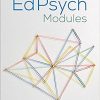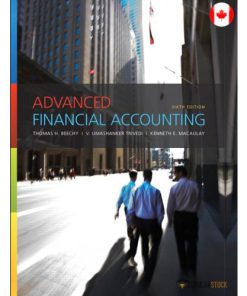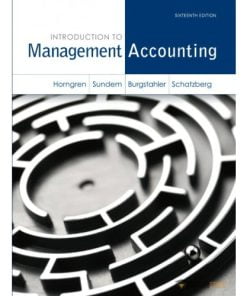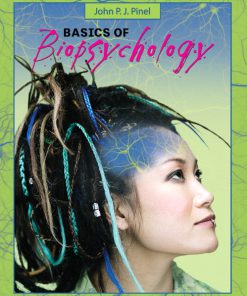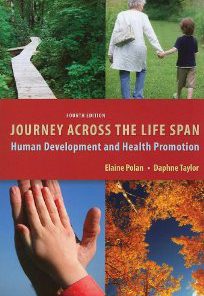Test Bank for Abnormal Child and Adolescent Psychology with DSM-V Updates, 8/E 8th Edition Rita Wicks-Nelson, Allen C. Israel
$35.00 Original price was: $35.00.$26.50Current price is: $26.50.
Test Bank for Abnormal Child and Adolescent Psychology with DSM-V Updates, 8/E 8th Edition Rita Wicks-Nelson, Allen C. Israel
Test Bank for Abnormal Child and Adolescent Psychology with DSM-V Updates, 8/E 8th Edition Rita Wicks-Nelson, Allen C. Israel
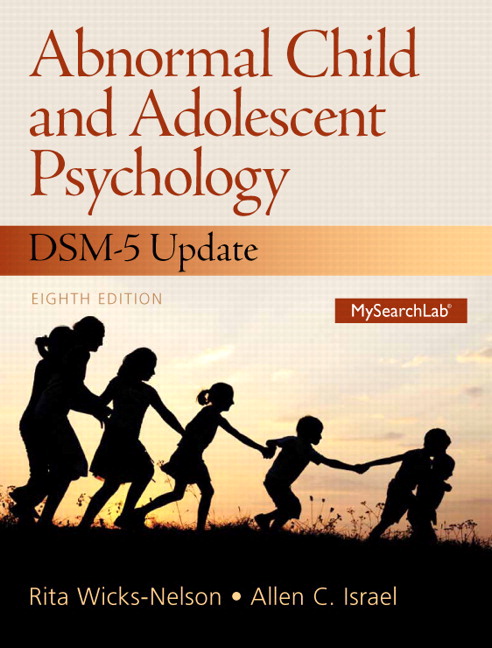
Product details:
- ISBN-10 : 9780133766981
- ISBN-13 : 978-0133766981
- Author: Allen C. Israel Ph.D
Abnormal Child and Adolescent Psychology with DSM-5 Updates, 8/e presents students with a comprehensive, research-based introduction to understanding child and adolescent psychopathology. The authors provide a logically formatted and easy to understand text that covers the central issues and theoretical and methodological foundations of childhood behavior disorders. Rich with illustrations and examples, this text highlights the newest areas of research and clinical work, stressing supported treatments and the prevention of behavior problems of youth.
Description:
CHAPTER 1
INTRODUCTION
TRUE OR FALSE
1. Ab means “away” or “from,” whereas “normal” refers to “average” or “standard.” Thus, abnormal is defined as something the deviates from the average.
2. Age is an important developmental index in judging behavior.
3. Cultural norms for behavior rarely impact diagnostic rates for a disorder.
4. Ethnicity denotes common customs, values, language or traits that are associated with national origin or geographic area.
5. A child’s behavior should be consistent and not vary across settings (e.g., classroom, playground, home).
6. In most cultures boys are expected to be less active and less aggressive than girls. This expectation is an example of a situational norm.
7. Youth rarely refer themselves for clinical evaluation.
8. According to the American Psychological Association, 10 percent of youth have a serious mental health disorder.
9. Quantifying the prevalence of disorders is difficult because it depends on several factors, including the definition of disorders, the population examined, and the methods used to identify the problem.
10. Changing social conditions may increase the risk of disorders in young people.
11. Early disturbances, for example, feeding issues or sleep disorders in infancy, do not have developmental consequences.
12. One difficulty in establishing the age of onset of any behavioral disorder is that the onset may occur gradually, so that age of onset may be an arbitrary estimation rather than a precise age.
13. Schizophrenia is a disorder that typically begins during childhood.
14. Males are more vulnerable than females to neurodevelopmental disorders that occur early in life.
15. One explanation for differing rates of behavioral disorder between boys and girls is gender differences in disruptive behavior, which can result in gender differences in referrals for clinical services.
16. The conceptualization of adolescence as a distinct period of life began in the 17th and 18th centuries.
17. Somatogenesis refers to the belief that behavioral disturbance results from a person’s being possessed or influenced by devils or some similar force.
18. Kraepelin is credited with creating a system to classify mental disturbances that serve as the basis for modern classification systems.
19. The belief that mental problems are caused by psychological variables is called psychogenesis.
20. Freud contributed to the field of childhood behavioral disorder by positing that early, unresolved psychological conflict is the source of emotional problems.
21. Behavior modification or behavior therapy is the explicit application of learning principles for the assessment and treatment of behavioral problems.
22. Longitudinal studies, focusing on normal development, assisted in the understanding and study of child and adolescent disorders.
23. Anna Freud, a mother and visionary, advocated establishing a Child Welfare Research Station at the University of Iowa.
24. Psychiatrists earn an M.D. and psychologists earn a Ph.D.
MULTIPLE CHOICE
25. Joe is in the second grade and cannot stay focused. He cannot read and tests below grade level in all subjects. He is rarely in trouble at school or at home. Joe
a. is free from all behavior disorders.
b. may have a behavioral disorder and should be evaluated.
c. is a typical boy.
d. is none of the above.
26. Which is least likely to be considered an indication of problem behavior in youth?
a. A behavior is excessively intense.
b. A behavior is qualitatively atypical.
c. A behavior is unusual but of no harm to anyone.
d. A behavior is exhibited in inappropriate settings.
27. Which of the following is a behavioral indicator of a disorder noted in Table 1.1?
a. Parental intolerance of atypical behavior
b. Bedwetting
c. Gender
d. Developmental delay
28. Serafica & Vargas (2006), found that:
a. anxiety is evident across cultures.
b. Asian and Latino groups express fewer bodily symptoms of anxiety.
c. Asian, Latino and European Americans did not differ in regard to symptoms of anxiety.
d. individuals living outside of the United States tend to deny symptoms of anxiety.
29. A study by Ly (2008) on parent perceptions of a child with intellectual disability found that compared to European American parents, Asian American parents:
a. viewed their child as less successful on task performance.
b. had higher expectations for future success.
c. had more sympathy for their child with a disability.
d. were no different in their views of their child.
30. Alicia’s mother is worried because although Alicia’s behavior seems much like that of her peers, Alicia misbehaves relative to the setting she is in. Alicia’s mother is concerned that her daughter is not meeting
a. gender norms. c. regression norms.
b. situational norms. d. developmental norms.
31. According to the book, which of the following is true regarding behavioral disorders of youth?
a. Judgments about abnormality often change over time.
b. Cultural norms should have no impact on diagnosis.
c. Disorders are best viewed as located within individuals.
d. Overall, girls display higher rates of externalizing behavior than boys.
32. Which of the following is true regarding preschooler mental health?
a. Preschoolers have fewer problems than older children.
b. Preschoolers have more problems, but tend to outgrow them.
c. The problems of preschoolers occur at the same rate as older children.
d. Secular trends indicate that the risks for young children and mental illness are decreasing.
33. Which of the following is true regarding the prevalence of behavioral disturbance of youth?
a. Collishaw (2010) found that the number of adolescents reporting emotional problems decreased from 1986 to 2006.
b. Research indicates that a majority of youth (80% or more) with mental health issues receive adequate mental health care.
c. Less than 10% of adults with mental illness report having symptoms in childhood or adolescence.
d. Prevalence rates are can vary depending on who is reporting on the symptoms (e.g., youth, parents, teachers).
34. With regard to childhood behavioral problems and age of youth,
a. little relationship exists between age and the occurrence of problems.
b. sometimes what seems to be a relationship between age and the occurrence of a specific disorder may actually reflect the time at which the disorder is first identified.
c. almost all behavior problems of young people appear in some form by age 6.
d. children cannot be diagnosed with a specific disorder until they are at least 8 years old.
35. With regard to gender and the rates of behavioral disorders,
a. boys are more likely to be diagnosed with externalizing disorders.
b. boys are more likely to be diagnosed with anxiety.
c. boys demonstrate higher levels of relational aggression.
d. externalizing problems increase for females as they get older.
36. Jake is a 9 year-old boy. What does thesay about his risk factors for psychopathology?
a. They do not differ from a 9 year old female.
b. He is at lower risk for neurodevelopmental disorders.
c. He is at higher risk for experiencing a traumatic brain injury.
d. He is at higher risk to experiencing an inappropriate sexual encounter.
37. Which of the following terms refers to biological causation of behavioral disturbance?
a. Egogenesis
b. Somatogenesis
c. Demonology
d. Operogenesis
38. When the term syndrome is used in reference to a behavioral disturbance, it suggests that the disorder
a. has a biological cause.
b. has a psychological cause.
c. occurs mostly in early childhood.
d. is characterized by a group of symptoms.
39. Who is credited with publishing, in the 19th century, an important classification system for mental disorders?
a. Freud c. Hillis
b. Myers d. Kraepelin
40. According to Table 1.3 in the book, who established the first child clinic in the United States?
a. Alfred Binet
b. Lightner Witmer
c. Arnold Gesell
d. Leo Kanner
41. Which of the following is true?
a. Freud’s theory adhered to the concept of psychogenesis.
b. Defense mechanisms serve no purpose.
c. The ego houses our unacceptable impulses.
d. Freud believed the personality was not completely formed until age 18.
42. In the case of “Little Hans,” Freud proposed that Han’s fear and anxiety were based in his
a. desire to have a mustache and wear glasses like his father.
b. wish for more attention from his father and his mother.
c. desire to own a horse.
d. sexual impulses toward his mother and fear of his father.
43. In Freudian theory, defense mechanisms are viewed as protecting the individual from
a. overstimulation.
b. understimulation.
c. recognizing one’s own unacceptable impulses.
d. seeking immediate sexual gratification.
44. In contrast to Sigmund Freud, John Watson argued for
a. an emphasis on internal psychological conflicts.
b. the study of biological influences on behavior.
c. an emphasis on learning experiences.
d. a stage theory of development.
45. The idea that behavior is shaped by its consequences is called _________ and was created by ______.
a. law of effect; Thorndike
b. psychoanalysis; Freud
c. classical conditioning; Watson
d. observational learning; Bandura
46. Who wrote the influential book, A Mind That Found Itself ?
a. Beers c. Hillis
b. Bandura d. Judge Baker
47. The child guidance movement in the United States
a. was related to the establishment of the Orthopsychiatric Association.
b. was an outgrowth of behaviorism.
c. received its impetus from longitudinal studies of children begun around 1920.
d. was based on the work of Hall at Clark University.
48. The theorist who linked the social context with cognition was
a. Anna Freud.
b. Emil Kraepelin.
c. Skinner.
d. Bandura.
49. Which name does not belong with the others?
a. Thorndike c. Skinner
b. Binet d. Watson
50. Who was the first president of the American Psychological Association?
a. Skinner c. Hall
b. Gesell d. Beers
51. Who is best known for early efforts to evaluate children’s intellectual functioning?
a. Binet and Simon c. Kraepelin
b. Healy and Bronner d. Beers
52. Mrs. Cora Bussey Hills was instrumental in
a. the establishment of the Juvenile Psychopathic Institute in Chicago.
b. the establishment of the Judge Baker Guidance Center in Boston.
c. the establishment of the Iowa Child Welfare Research Station.
d. the establishment of the Fels Research Institute at Berkley.
53. A __________ is a trusting, personal bond formed between the therapist and the client.
a. confidentiality agreement
b. therapeutic alliance
c. treatment contract
d. working relationship
BRIEF ESSAY QUESTIONS
54. Discuss three indicators that influence whether a child or adolescent will be identified as experiencing a behavioral problem.
55. Discuss how culture can influence the definition and understanding of disordered behavior of youth.
56. List and describe the four variables that are important to note in regard to infant mental health.
57. How can gender bias in clinic samples indirectly affect gender differences in the prevalence of behavioral disorders (what methodological issues can create the appearance of gender differences)?
58. Discuss three aspects of Freud’s theory that framed his important view of psychological disturbances in youth and adults. How has psychoanalysis changed over the years?
59. Briefly describe classical conditioning, operant conditioning, and observational learning.
60. Summarize the aims and early history of the mental hygiene and the child guidance movements.
61. List five themes (premises) viewed by the text’s authors as central to the current study and practice of developmental psychopathology.
62. Define informed consent and how it applies to child therapy.
ANSWER KEY
1. T, p. 3, factual
2. T, p. 3, factual
3. F, p. 4, conceptual
4. T, p. 4, factual
5. F, p. 5, conceptual
6. F, p. 5, factual
7. T, p. 5, factual
8. T, p. 6, conceptual
9. T, p. 6, factual
10. F, p. 6, factual
11. F, p. 7, conceptual
12. T, p. 8, factual
13. F, p. 8 (Fig 1.4), factual
14. T, p. 9, factual
15. T, pp. 9-10, factual
16. T, p. 10, factual
17. F, p. 10, factual
18. T, p. 11, applied
19. T, pp. 11-12, factual
20. T, p. 12, applied
21. T, p. 14, factual
22. T, p. 15, factual
23. F, p. 15, applied
24. T, p. 16, factual
25. B, p. 3, applied
26. C, p. 3, conceptual
27. D, p. 3 (Table 1.1), factual
28. A, p. 3, applied
29. A, p. 4, applied
30. B, p. 5, conceptual
31. A, pp. 3-6, conceptual
32. C, p. 6, factual
33. D, pp. 6-8 (Figure 1.3), applied
34. B, p. 8 (Figure 1.4), factual
35. A, p. 9, Table 1.2, & Figure 1.5, factual
36. C, pp. 8-9, applied
37. B, p. 10, factual
38. D, p. 11, factual
39. D, p. 11, applied
40. B, p. 11, Table 1.3, applied
41. A, pp. 11-12, applied
42. D, p. 12 (accent), applied
43. C, p. 12, conceptual
44. C, p. 13, applied
45. A, p. 13, applied
46. A, p. 14, applied
47. A, p. 14, factual
48. D, p. 14, applied
49. B, pp. 13-15, applied
50. C, p. 15, applied
51. A, p. 15, applied
52. C, p. 15 (accent), applied
53. B, p. 17, factual
54. p. 3, factual
55. pp. 3–5, conceptual
56. p. 7 (accent), factual
57. pp. 9-10, factual
58. pp. 11-12, applied
59. pp. 13-14, factual
60. p. 14, factual
61. p. 16, factual
62. p. 17, factual
People also search:
|
abnormal child and adolescent psychology (8th edition pdf free)
abnormal child and adolescent psychology 8th edition
what is abnormal child psychology
what does a child and adolescent psychologist do
what is child and adolescent psychology
|
Related products
Test Bank
Test Bank for Operating Systems: Internals and Design Principles, 7th Edition: William Stallings



